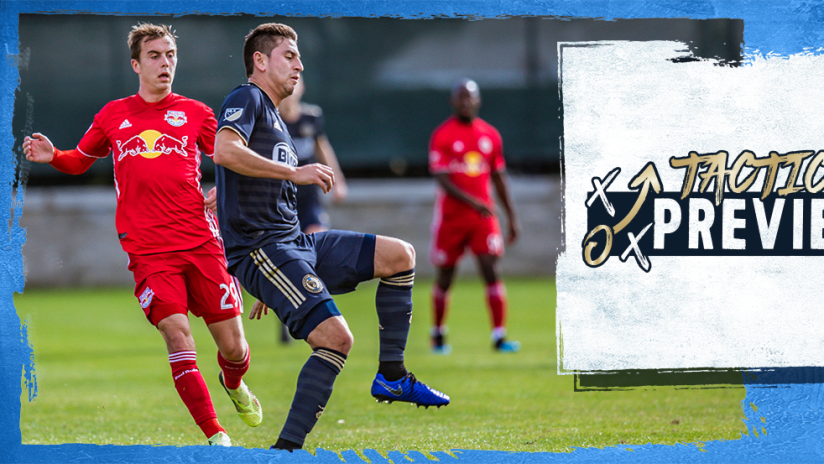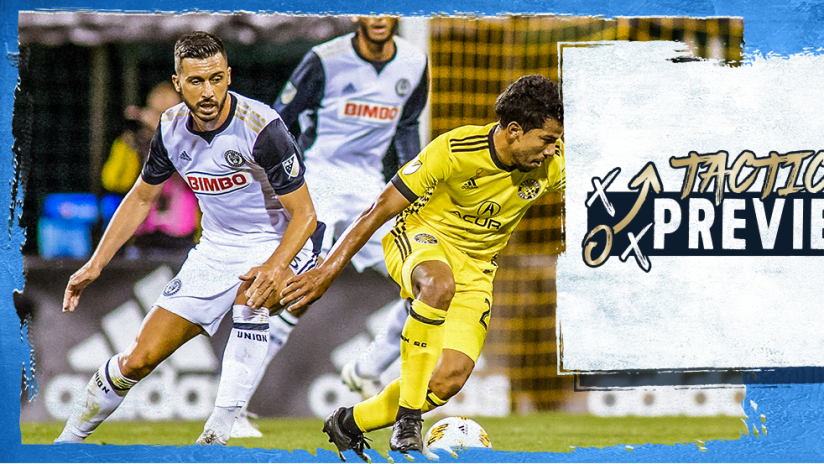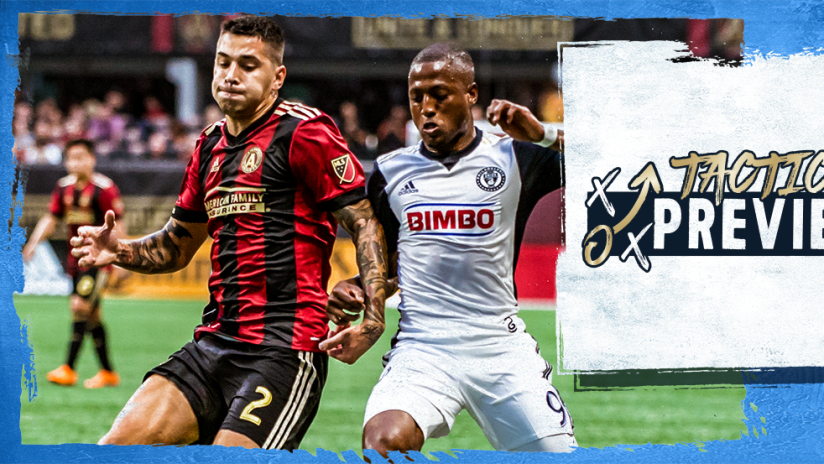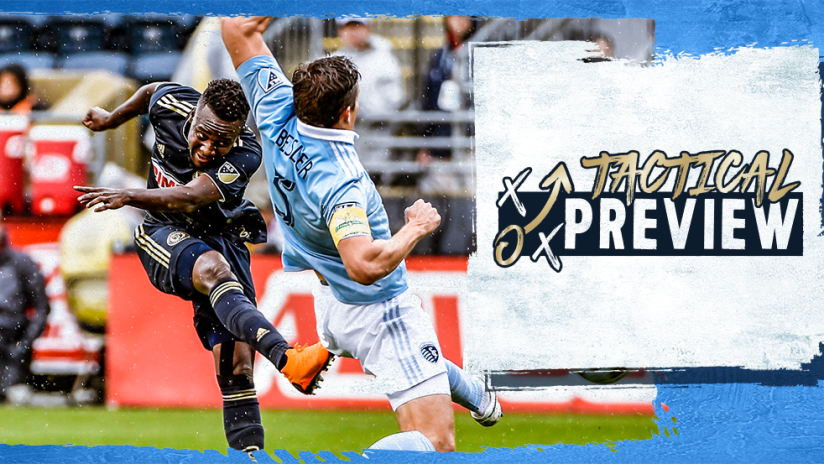Since Ernst Tanner arrived as the Union's new Sporting Director, he has emphasized the need to provide Jim Curtin with the ability to play in a flexible and adaptive tactical system that can be implemented with a clear methodology. Late in 2018, minor adjustments were already being made; Tanner and Curtin both spoke about tweaking how the team pressed and defended against Seattle when the Union, playing on the road, broke the Sounders' nine-match winning streak.
During the 2019 preseason, a change in formation has become the dominant narrative surrounding the Union, and Curtin's two-striker shape is a clear visual departure from the look favored over the past three seasons. But the bigger question may be how this shape changes the ways the Union control space defensively and create it in the attack.
New Philosophy
In soccer, the final objective always remains the same: Score more goals than your opponent as often as possible. Getting from a round object and 22 humans (or 21 and Lionel Messi) to that endpoint requires interacting strategies on and off the pitch and an incredibly precise level of execution within a sea of uncertainties. And that's what makes it fun.
The first big storyline for 2019, then, is how the philosophy introduced by Ernst Tanner shapes how the Union make decisions on and off the pitch. That philosophy, and the methodology used to implement it, is meant to provide paths through uncertainty the give clarity to decision-making. This is how the Union can trade an unprecedented five draft picks away and shrug off counterarguments -- the internal development tenet of the philosophy suggests that there are advantages to prioritizing the talent you know best if you think it is roughly on par with college talent. Union academy graduates such as ACC Freshman of the Year (and, notably, new Bethlehem Steel signee) Issa Rayyan have found success in the college ranks, so the Union's strategy appears to make sense.
What Union fans want to watch, then, is how this philosophy continues to guide how the team behaves.
New tactics
On the pitch, the clearest indications of the new philosophy are the tactics the team deploys and the personnel brought in to execute those tactics. Jim Curtin returns as head coach because Tanner believes he's capable of implementing the narrow, vertically-compact, and aggressive system the Sporting Director favors. It's not a simple ask, by any means, and the fact that Tanner thinks Curtin can do it should speak volumes to those outside of the club that have questioned what the head coach brings to the table.
Transition Moments
The biggest talking point early on has been the new shape that the Union will use to reach their aims on the pitch. Beyond scoring and preventing goals, those aims include controlling the center of the pitch, creating discomfort on the ball for opposition defenders, remaining compact across the pitch, compressing space vertically, and becoming extremely dangerous in attacking transition moments. That is only a very incomplete subset of the Union's tactical goals, but already the benefits of the two-striker shape begin to come into focus. Two strikers means more bodies upfield following turnovers, and it often means at least one striker will be central and able to push the first pass following a giveaway wide. For the same reason Curtin often talked about a desire for his team to play forward first after a turnover last year, the Union want their opposition to be forced wide or backward. The key moments to exploit in modern soccer are those that occur in the few seconds following a change in possession, and the Union want to play in a shape that allows them to remain in control of transition moments even when they are the defending team.
If you are an American football fan, one way to think about the value of transition moments is by focusing on no-huddle offenses. The main advantage the offense gains from a no-huddle approach is that the defense does not have time to re-organize itself before the next snap is called. In the same way, a team that can move quickly into attack following a turnover can catch the defense before it has arranged itself. In those moments, talent advantages are overwhelmed by organizational advantages, and the more disciplined, well-trained squad can overcome a group of individuals, no matter how talented.
By now, it should become clear that a two-striker shape is not preferred because strikers are inherently better finishers or because, by default, playing with two strikers makes a team better in attack. Instead, playing with two strikers is about controlling the spaces you want to control in the key moments of the match.
Behind the two-striker look, the Union have operated with a midfield diamond. In contrast, Bethlehem Steel have used more of a 4-2-2-2 shape. This difference is important because it points to the formational flexibility the club has within their 4-4-2 shape. The diamond provides a different set of advantages than the box, and those advantages can be maximized by players used in the system.
Why the diamond?
The Union have two clear reasons to use a diamond, and one more subtle reason. The two: Haris Medunjanin and Marco Fabian. Medunjanin's most notable attribute over the past two seasons has been his ability to spread the field two-dimensionally -- both vertically and horizontally. To utilize this skill, the Union spread their shape wide when in possession and sought to find players like Fafa Picault, David Accam, and Ilsinho in space so they could attack defenders 1v1.
But that field-spreading ability is just one potential manifestation of Medunjanin's skillset. What truly sets him apart is the ability to control the rhythm of a match no matter how his teammates shape up around the ball. Thus, in preseason the Union have used the Bosnian at the base of a diamond and allowed him to draw defenders upfield. Once the defense has committed forward, Medunjanin is calm enough in tight spaces to identify both the longer angled passes he's well known for and the direct looks through the center and into channels that bypass a defense centrally and end up at the feet of Marco Fabián.
Unlocking these more central attacking routes is one of the goals of a transition-oriented attack, and the Union can try to create those same openings by sitting Medunjanin deep in a diamond shape.
As the second piece of the puzzle that Philly has been solving with a diamond midfield, Fabián provides a rare combination of intelligent movement, goal threat, and a nose for unlocking defenses with a pass. At his best he's a skeleton key, and the Union want runners arriving into spaces around him rather than drawing defenders to him when he receives the ball. The two wider players in the diamond, then, follow passes through the lines and either draw bodies away from Fabián or take the spaces he vacates and trust him to cast the spells necessary to find them.
Notably, Fabián's movement is not simply a catalyst for complementary runs through midfield. In preseason, the Union's strikers have, at times, also looked to occupy the spaces he leaves in the center. This forces the opposition center backs to make a decision: Follow into the hole or stay in the back line? A 'follow' forces the other defenders to read and adjust, often by becoming narrow and opening the flanks for Philly's advancing fullbacks. A 'stay' leaves the striker in space, and all of Philly's corps of front liners becomes a dangerous weapon when facing goal with space to advance.
The subtle reason? That's the perpetually underrated Ale Bedoya. Among his talents, Bedoya's reading of the game is the one that makes him truly remarkable. Being able to tuck in as support for Medunjanin, slip out wide to prevent 2v1s, and surge forward to run off of Fabián -- and do it all at the right times -- makes Bedoya that rare player who can interpret a single position as three or more at the same time as a match develops. Asking the same of anybody in the other No. 8 role would be ludicrous; so on the opposite side of midfield the Union can rotate players that fit the strategy of the match. Attacking nous? Ilsinho's available. Extra defensive help? Warren Creavalle and Derrick Jones are on hand. Want to press the air out of the opponent's lungs for 70 minutes? Welcome to the Brenden Aaronson show. And if you need a ball mover, Anthony Fontana is always ready.
Fullbacks fly around, but thoughtfully
But why this focus on the midfield when the fullbacks and their entire-flank-covering roles have been a far larger story throughout preseason? For one, the more important point may be that the Union haven't played with wingers occupying the attacking wide spaces. In 2018, Keegan Rosenberry was often responsible for the entire right flank -- particularly when paired with CJ Sapong. Now, the fullbacks don't have the luxury of a winger outside creating a 2v1 or drawing the attention of the opposing fullback, so attacking movements require a close reading of the game and anticipating opponent movements. Additionally, the fullbacks must be willing to press forward following turnovers rather than retreating, and they must make this decision extremely quickly. Thus, when a discussion of how much space the Union's fullbacks must cover in this 4-4-2 shape zeroes in on the physical ask made of the players, it can overlook the far larger issue: The mental side of this role is unbelievably difficult to master.
Control the center
Between the fullbacks, Philadelphia's central defenders and goalkeeper form an incredibly important triangle. For the central defenders, positioning themselves to monitor and attack balls into gaps in front of them while remaining connected to their teammates is often a function of possession defending -- remaining alert to the possibilities that could occur following a turnover and moving accordingly. The goalie, then, can be left with gigantic swaths of space to cover behind his aggressive line. Remaining in the 18-yard box is not an option. Andre Blake must instead take on a libero-type role in back, stepping forward quickly to ensure the Union are truly connected from front to back. Blake's positioning will be an underrated but absolutely key part of Philly's defensive fortuntes this season, and it is one that asks the Jamaican to continue growing his game beyond his excellent shot-stopping.
In attack, the Union's center backs will seek to move the ball with speed in order to shift the opponent's defense. Just as they did a year ago, the CB on the ball will look for Medunjanin's feet or for the player dropping into a zone the Bosnian vacates. The desire for long switches of play will likely be weaker than before, but the willingness to play the ball into tight spaces in the channels should increase. This is because these are the areas Philly will have players around the ball to quickly counterpress. What may look like a risky pass at first, then, may actually be one that creates a situation primed for a turnover and quick attacking transition.
In the end...
As Ernst Tanner and Jim Curtin noted in their season opening press conference, fully adopting the complex pressing system that fans have only glimpsed so far will take take. Early in the season, Philly will look to maintain constant control of space in the middle of the pitch and prevent their opponent from having the time to switch the ball and stretch out their compact shape. Over time, expect increasingly nuanced defensive looks that challenge MLS central defenders on the ball and strategically target opponent weak points.
And on Saturday? Expect energy, aggression, and a well-connected shape with small gaps between players. That's the visual Ernst Tanner's philosophy produces when executed well, and Tanner has said he is happy with how Jim Curtin has begun instituting that philosophy thus far.
The first test will be a big one, and a wild one in Talen Energy Stadium.
Make sure you are there for it.
Tactical Preview
Tactical Preview: Union vs Toronto FC

Stay in the Know
Stay in the Know

UNION NEWSLETTER
The Boys in Blue, delivered to your inbox. Tickets, deals, giveaways, and more.
Latest News
Latest News
-
Quinn Sullivan voted 2025 IBX Player of the Year
-
Quinn Sullivan wins 2025 Primepoint Assist of the Year
-
Philadelphia Union Adquiere Hasta $4.600.000 de D.C. United
-
Philadelphia Union Acquire Up To $4,600,000 From D.C. United
-
Philadelphia Union to participate in Leagues Cup 2026; Set to be Played August 4-September 6
-
Blake double save voted 2025 Philadelphia Inquirer Save of the Year
-
Philadelphia Union Acquire Up To $2,200,000 In General Allocation Money From LA Galaxy











